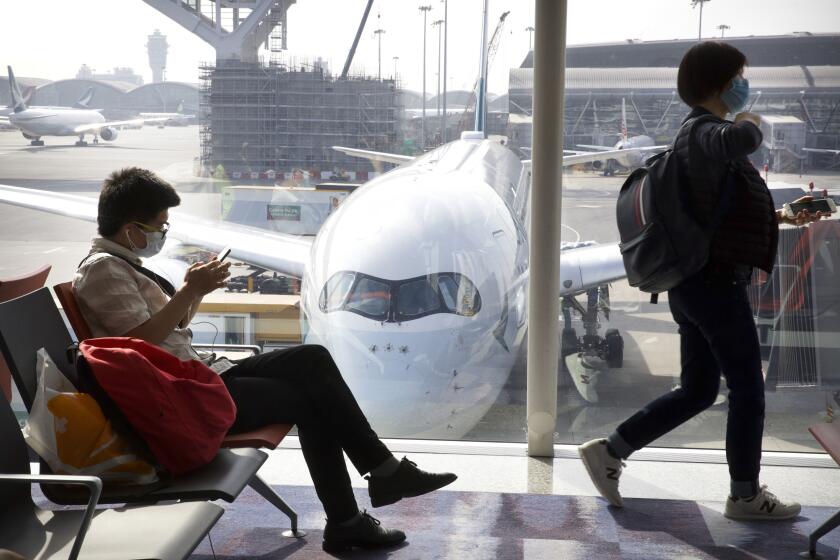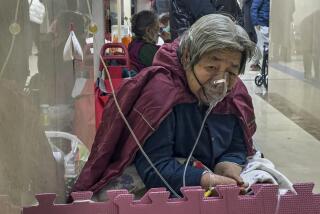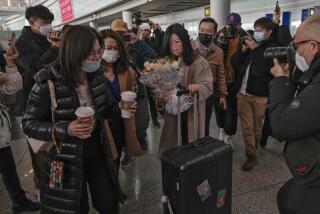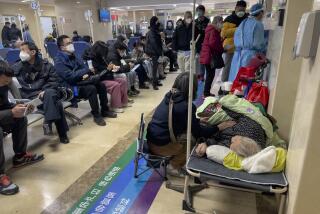China locks down cities with 18 million to contain deadly coronavirus

BEIJING — Chinese authorities Thursday moved to lock down at least three cities with a combined population of more than 18 million in an unprecedented effort to contain the deadly new virus that has sickened hundreds of people and spread to other parts of the world during the busy Lunar New Year travel period.
The open-ended lockdowns are unmatched in size, embracing more people than New York City, Los Angeles and Chicago put together.
The train station and airport in Wuhan, the epicenter of the outbreak, were shut down, and ferry, subway and bus services were halted. Normally bustling streets, shopping malls, restaurants and other public spaces in the city of 11 million were eerily quiet. Police checked all incoming vehicles but did not close off the roads.
Authorities announced similar measures would take effect Friday in the nearby cities of Huanggang and Ezhou. In Huanggang, theaters, internet cafes and other entertainment centers were also ordered closed.
In the capital, Beijing, officials canceled “major events” indefinitely, including traditional temple fairs that are a staple of holiday celebrations, in order to “execute epidemic prevention and control.” The Forbidden City, the palace complex in Beijing that is now a museum, announced it will close indefinitely on Saturday.
Seventeen people have died in the outbreak, all of them in and around Wuhan. Close to 600 have been infected, the vast majority of them in Wuhan, and many countries have begun screening travelers from China for symptoms of the virus, which can cause fever, coughing, breathing trouble and pneumonia.
Meanwhile, the World Health Organization decided against declaring the outbreak a global health emergency for now. Such a declaration can bring more money and other resources to fight a threat but can also trigger economically damaging restrictions on trade and travel in the affected countries, making the decision a politically fraught one.
The decision “should not be taken as a sign that WHO does not think the situation is serious or that we’re not taking it seriously. Nothing could be further from the truth,” WHO Director General Tedros Adhanom Ghebreyesus said. “WHO is following this outbreak every minute of every day.”
But while the epidemic was clearly a crisis in China, “it has not yet become a global health emergency. It may yet become one,” he added.
Chinese officials have not said how long the shutdowns will last. While sweeping measures are typical of China’s communist government, large-scale quarantines are rare around the world, even in deadly epidemics, because of concerns about infringing on people’s liberties. And the effectiveness of such measures is unclear.
“To my knowledge, trying to contain a city of 11 million people is new to science,” said Gauden Galea, WHO’s representative in China. “It has not been tried before as a public health measure. We cannot at this stage say it will or it will not work.”
Jonathan Ball, a professor of molecular virology at the University of Nottingham in Britain, said the lockdowns appear to be justified scientifically.
“Until there’s a better understanding of what the situation is, I think it’s not an unreasonable thing to do,” he said. “Anything that limits people’s travels during an outbreak would obviously work.”
Health officials around the world are keeping a close watch on an outbreak of a virus in China. Here’s what you need to know about the coronavirus.
But Ball cautioned that any such quarantine should be strictly time-limited. He added: “You have to make sure you communicate effectively about why this is being done. Otherwise you will lose the goodwill of the people.”
During the devastating West Africa Ebola outbreak in 2014, Sierra Leone imposed a national three-day quarantine as health teams went door to door, searching for hidden cases. Frustrated residents complained of food shortages amid deserted streets. Burial teams collecting corpses and people transporting the sick to Ebola centers were the only ones allowed to move freely during the lockdown.
In China, the illnesses from the newly identified coronavirus first appeared last month in Wuhan, an industrial and transportation hub in central China’s Hubei province. Other cases have been reported in recent days in the U.S., Japan, South Korea and Thailand. Singapore, Vietnam and Hong Kong reported their first cases Thursday.
Most of the illnesses outside China involve people who were from Wuhan or had recently traveled there.
Images from Wuhan showed long lines and empty shelves at supermarkets as residents stocked up for what could be weeks of isolation. That appeared to be an overreaction, since no restrictions were placed on trucks carrying supplies into the city, but many Chinese have strong memories of shortages in the years before the country’s recent economic boom.
Local authorities in Wuhan demanded all residents wear masks in public places. Police, SWAT teams and paramilitary troops guarded Wuhan’s train station.
Liu Haihan left Wuhan last Friday after visiting her boyfriend there. She said everything was normal then, before human-to-human transmission of the virus was confirmed. But things had changed rapidly.
Her boyfriend “didn’t sleep much yesterday. He disinfected his house and stocked up on instant noodles,” Liu said. “He’s not really going out. If he does, he wears a mask.”
The sharp rise in illnesses comes as millions of Chinese travel for the Lunar New Year, one of the world’s largest annual migrations of people. Chinese are expected to take an estimated 3 billion trips during the 40-day spike in travel.
Analysts predicted coronavirus cases will continue to multiply, although the jump in numbers is also attributable in part to increased monitoring.
“Even if [cases] are in the thousands, this would not surprise us,” said WHO’s Galea, cautioning that the number of those infected is not an indicator of the outbreak’s severity, so long as the mortality rate remains low.
The coronavirus family includes the common cold as well as viruses that cause more serious illnesses, such as the SARS outbreak that spread from China to more than a dozen countries in 2002-03 and killed about 800 people, and Middle Eastern respiratory syndrome, or MERS, which is thought to have originated from camels.
China is keen to avoid repeating mistakes with its handling of SARS. For months, even after the illness had spread around the world, China parked patients in hotels and drove them around in ambulances to conceal the true number of cases and avoid WHO experts. This time, China has been credited with sharing information rapidly, and President Xi Jinping has emphasized that as a priority.
Health authorities are taking extraordinary measures to prevent additional person-to-person transmissions, placing those believed infected in plastic tubes and wheeled boxes, with air passed through filters.
The first cases in the Wuhan outbreak were connected to people who worked at or visited a seafood market, which has since been closed. Experts suspect that the virus was first transmitted from wild animals, but that it may also be mutating. Mutations can make it deadlier or more contagious.
WHO defines a global emergency as an “extraordinary event” that constitutes a risk to other countries and requires a coordinated international response. Previous global emergencies have been declared for the emergence of the Zika virus in the Americas, the swine flu pandemic and polio.
Countries typically resist the notion that they have a crisis within their borders and may argue strenuously for other control measures.
More to Read
Sign up for Essential California
The most important California stories and recommendations in your inbox every morning.
You may occasionally receive promotional content from the Los Angeles Times.










